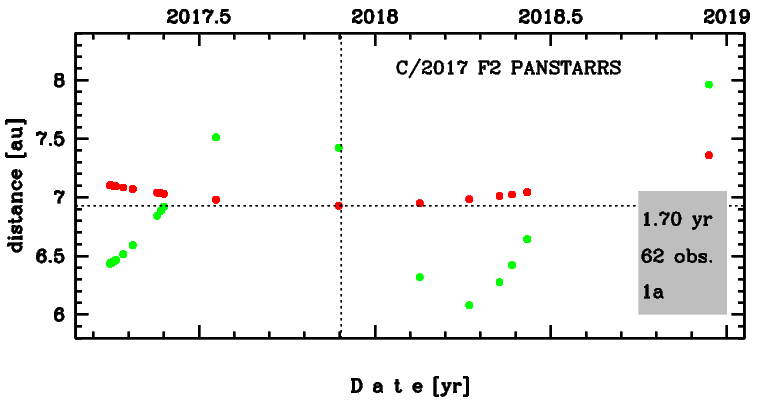C/2017 F2 PANSTARRS
more info
Comet C/2017 F2 was discovered on 31 March 2017 with Pan-STARRS 1 telescope (Haleakala), that is about 8 months before its perihelion passage. This comet was rarely observed until 6 March 2019.
Comet had its closest approach to the Earth on 31 March 2018 (6.070 au), about 4 months after its perihelion passage.
The preferred solution given here is based on data spanning over 1.93 yr in a range of heliocentric distances: 7.10 au – 6.928 au (perihelion) – 7.56 au.
This Oort spike comet suffers moderate planetary perturbations during its passage through the planetary system; these perturbations lead to escape the comet from the planetary zone on a hyperbolic orbit (see future barycentric orbits).
Comet had its closest approach to the Earth on 31 March 2018 (6.070 au), about 4 months after its perihelion passage.
The preferred solution given here is based on data spanning over 1.93 yr in a range of heliocentric distances: 7.10 au – 6.928 au (perihelion) – 7.56 au.
This Oort spike comet suffers moderate planetary perturbations during its passage through the planetary system; these perturbations lead to escape the comet from the planetary zone on a hyperbolic orbit (see future barycentric orbits).
| solution description | ||
|---|---|---|
| number of observations | 62 | |
| data interval | 2017 03 31 – 2018 12 12 | |
| data type | perihelion within the observation arc (FULL) | |
| data arc selection | entire data set (STD) | |
| range of heliocentric distances | 7.1 au – 6.93 au (perihelion) – 7.35 au | |
| detectability of NG effects in the comet's motion | NG effects not determinable | |
| type of model of motion | GR - gravitational orbit | |
| data weighting | NO | |
| number of residuals | 112 | |
| RMS [arcseconds] | 0.37 | |
| orbit quality class | 1a | |
| orbital elements (heliocentric ecliptic J2000) | ||
|---|---|---|
| Epoch | 2017 11 23 | |
| perihelion date | 2017 11 26.39477058 | ± 0.00772893 |
| perihelion distance [au] | 6.92768201 | ± 0.00002120 |
| eccentricity | 1.00537344 | ± 0.00002119 |
| argument of perihelion [°] | 134.917674 | ± 0.000567 |
| ascending node [°] | 38.668130 | ± 0.000065 |
| inclination [°] | 42.507672 | ± 0.000035 |
| reciprocal semi-major axis [10-6 au-1] | -775.65 | ± 3.05 |
